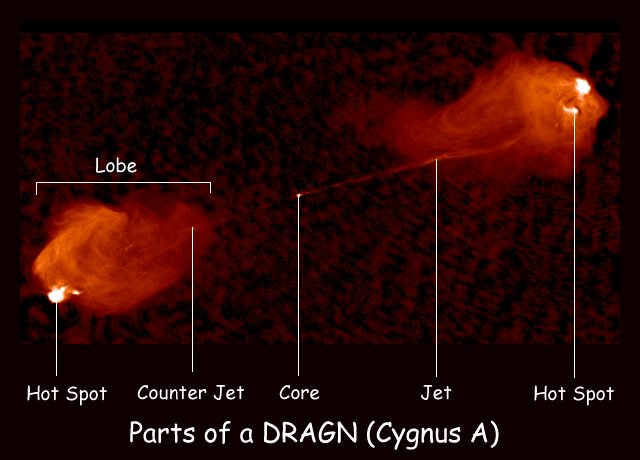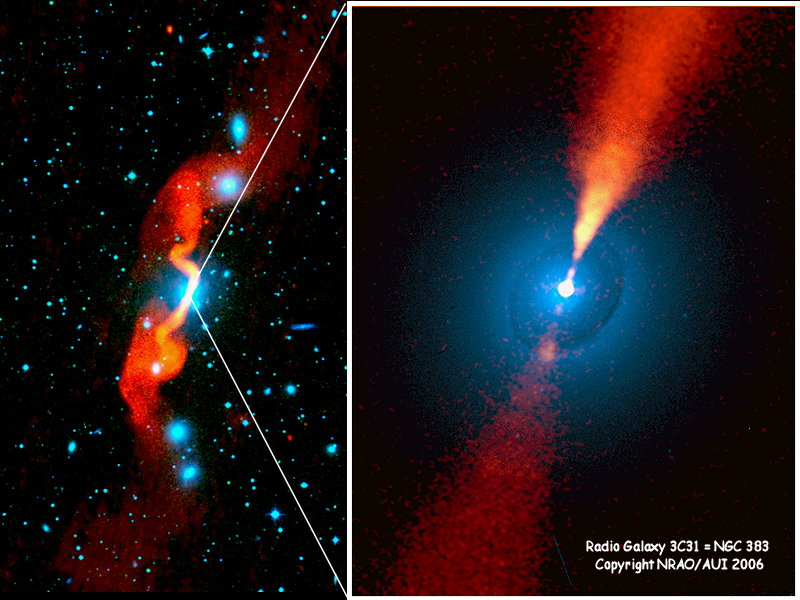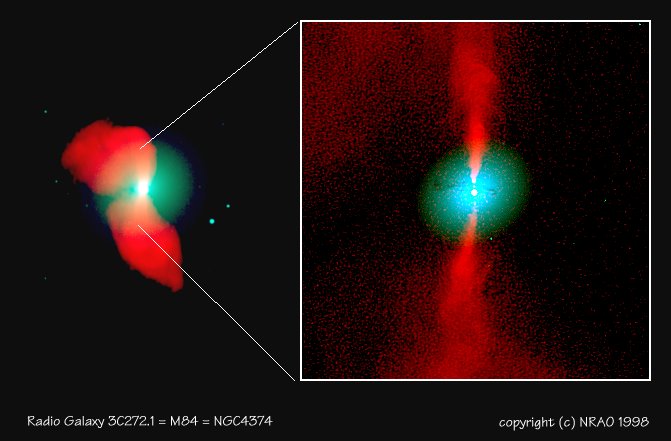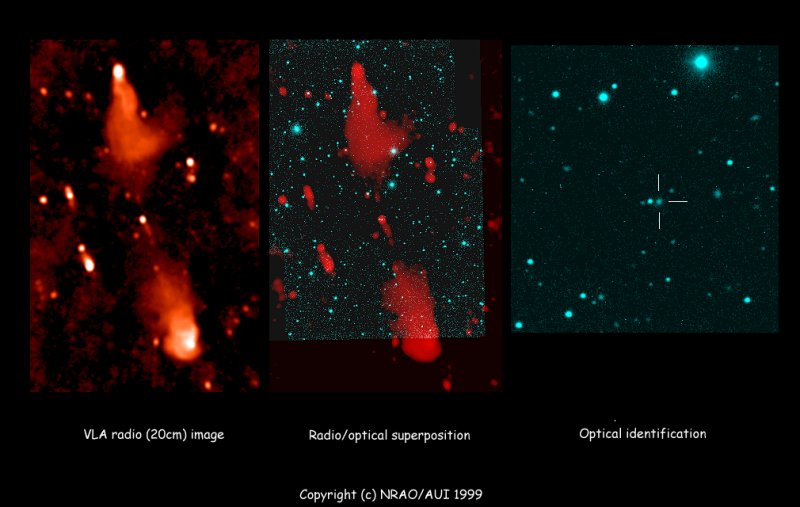



Double Radio Sources
Associated with
Galactic Nuclei




DRAGNs are large-scale double radio sources produced by outflows (jets) that are launched by processes in active galactic nuclei (AGN).
The term DRAGN is an acronym for "Double Radio Source Associated with a Galactic Nucleus" . It was coined by Patrick Leahy in 1993 (in Jets in Extragalactic Radio Sources, eds. Röser, H.-J., & Meisenheimer, K.; Berlin: Springer-Verlag).
The more general term extragalactic radio source means, literally, any object located outside our Milky Way galaxy that emits detectable radio waves.
Most of the extragalactic sources detected by early radio surveys were DRAGNs, but modern deep radio surveys also detect many sources produced by "starbursts" in galaxies. Starbursts can produce radio emission throughout an extended region of a galaxy, but do not produce significant radio emission in regions far from the stars that have formed. DRAGNs fundamentally involve the mass concentration in the nucleus of the galaxy and produce radio emission throughout regions that are much larger than the host galaxies themselves.
DRAGNs are formed when an active galactic nucleus produces two persistent, oppositely-directed plasma outflows that contain cosmic ray electrons and magnetic fields. We do not know exactly what these "jet" outflows contain, but they clearly include fast-moving electrons and partially ordered magnetic fields which make them visible at radio (and higher) frequencies by their synchrotron radiation (emission that occurs when electrons move across a magnetic field at almost the velocity of light). To preserve overall charge neutrality, there must also be either protons or positrons in the outflows.
 The process that launches the plasma jets is thought to be the winding up of
magnetic fields in an accretion disk that forms around a massive
black
hole in the galactic nucleus. The winding of the fields provides a way
to convert gravitational and rotational energy into bulk outflows at high speeds
perpendicular to the disk. The basic scheme is sketched in the HEASARC
animation at the left, which zooms in from a distant side view to look down onto
the black hole in a close-up from near the rotation axis of the disk.
(There is a another good sketch of the basic
ingredients of the "central engine" of an active galactic nucleus
here).
The process that launches the plasma jets is thought to be the winding up of
magnetic fields in an accretion disk that forms around a massive
black
hole in the galactic nucleus. The winding of the fields provides a way
to convert gravitational and rotational energy into bulk outflows at high speeds
perpendicular to the disk. The basic scheme is sketched in the HEASARC
animation at the left, which zooms in from a distant side view to look down onto
the black hole in a close-up from near the rotation axis of the disk.
(There is a another good sketch of the basic
ingredients of the "central engine" of an active galactic nucleus
here).
The outflow speeds in AGN are thought to be initially supersonic (i.e., the flows are faster than the speed of sound in the jet plasma). The radio jet structures show much evidence for high Mach numbers: excellent collimation, features that resemble internal shock waves, and large-scale stability (the ability to propagate to large distances without being disrupted)..

The main radio structures in a powerful DRAGN whose jets stay supersonic to great distances are illustrated above with the VLA image of the radio galaxy 3C405 (Cygnus A). A compact radio source usually described as the "core" coincides with the galactic nucleus. Most of the radio emission does not come directly from the well-collimated "jets", but from the broader "lobes" that are found around the jet paths. The plasma in the lobes is believed to have been supplied by the jets over millions of years. In the more powerful DRAGNs, there are usually small, bright radio "hot spots" near the boundaries of each lobe. These hot spots thought to be where strong shocks form near the ends of the supersonic jet outflows in the powerful DRAGNs.
The environs of a galaxy are not a perfect vacuum. The jets must travel first through the atmosphere of the active nucleus, then through the interstellar medium of the host galaxy, then (if they get that far without being slowed down by interacting) through the successively lower densities and pressures of the outer halo of the galaxy, the intra-cluster medium of any surrounding group or cluster of galaxies, and finally into the low-density inter-galactic medium. The jets do not flow freely away from the AGN, but must push their way through these external media.
There is good evidence that the outflow speeds in DRAGNs are initially relativistic, i.e. that the material travels outwards at a large fraction of the velocity of light, often with Lorentz factors of order 10. The velocities appear to decrease along many of the the jets, however. In the less powerful sources, it appears that the jets are slowed down enough on the scale of the galaxy to become subsonic and turbulent. These "Type I" sources form large-scale plumes that meander across the sky at the mercy of pressure gradients, shocks and winds in the large-scale intracluster or intergalactic media. An example is 3C31 (identified with the galaxy NGC383), shown below with the DRAGN in red and the optical field in blue:

(See the 3C31 image pages for more details).
In more powerful (Type II) sources, it appears that the jets remain at least mildly relativistic (and supersonic) out to great distances from their host galaxies, to form the 'claasical" double-lobed structures like that shown above for 3C405 (Cygnus A). In the Type II sources the ends of the jets move outwards more slowly than material flows along the jet. The plasma arriving at the end of their jets is then deflected back around them to form the lobes, large "bubbles" in the medium surrounding the galaxy.
Individual DRAGNs will tend to grow while their central "engine" remains active.
The smallest DRAGNs known are only a few tens of parsecs across,
contained within in the active nucleus. An example of a weak, small DRAGN on a
galactic scale is 3C272.1, associated with the Virgo Cluster
elliptical galaxy M84 (NGC4374), shown below with the DRAGN in red and
the optical field in blue:

(See the 3C272.1 image page for more details).
At the other extreme, giant DRAGNs are the largest known objects, up to several Megaparsecs from end to end. The lobes of the radio source shown below were discovered by a low-resolution all-sky survey made with the VLA. They were later shown to be a single DRAGN by observations that revealed the radio core and the jets connecting it to these lobes (left panel). The core coincides (central panel) with a galaxy (right panel) whose redshift is z=0.154. This reveals the double radio source to be over 4 Mpc in extent, and the second largest DRAGN known. The largest of them all, 3C236, is about 6 Mpc across.

Typical powerful DRAGNs are hundreds of kiloparsecs across, several times bigger than their host galaxies.
Powerful DRAGNs have estimated lifetimes of order 20 million years; this makes them a brief outburst in the life of a galaxy (compare the 100 million years a star may take to orbit the galaxy's hub). On the other hand, weak DRAGNs are so common in the largest elliptical galaxies that the jets must be "on" essentially all the time.
DRAGNs are almost invariably associated with elliptical galaxies, rather than with spirals. There appears to be a strong connection, still to be explained in detail, between the processes that determine the bulge-to-disk ratio of the host galaxy and the ability to form (and maintain) the active nuclear "engine" for the time it takes to build up a large-scale DRAGN.
Patrick Leahy, Richard Strom, and I have collected an Atlas of DRAGNs that includes images, vital statistics and brief descriptions of each object. The atlas is served from Patrick's web site at Jodrell Bank. The Atlas is a complete sample of all the DRAGNs from the Third Cambridge Catalogue of Radio Sources (Second Revision, known as 3CRR), out to a redshift of z=0.5.
My Radio Galaxy and Quasar Image Gallery contains high-resolution images that show the main types of DRAGN structures in greater detail than is currently available for most of the Atlas members.
 Go back to:
Go back to:
Last updated: 2006 June 28, 14:13 EDT